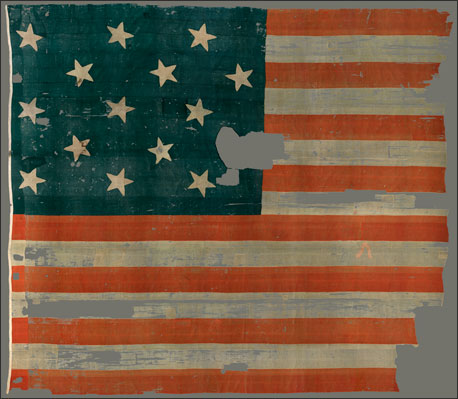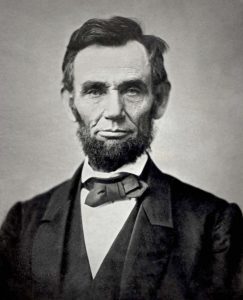Francis Scott Key was born on August 1, 1779 in Terra Rubra, Maryland. After graduating college, Key began to study law in hopes of becoming an attorney.1 Soon after, Keys got married and had eleven children and moved to Georgetown where he started his own practice.2 Key became very successful in his work as a lawyer, and for hobbies he sang for the church and wrote poems, a lot of which are still appreciated today. When the War of 1812 broke out, Key enlisted in the US army.3

Francis Scott Key was sent to a British ship to negotiate the release of certain prisoners. Upon Key’s arrival to the ship, he showed the Commodore of the ship letters from British troops that had been captured by American forces.4 The letters explained how well they were being treated and that they were not harmed in any way. After seeing this, the Commodore let their prisoner William Beanes free, but before the three American men could leave, the British troops were preparing to attack Fort McHenry, and therefore needed to keep them on the ship so that they would not be able to return back to warn the American troops.5
For over twenty-four hours the two sides, American and British, exchanged fire. The British recorded that “over eight hundred shells” were shot at the fort.6 After twenty-four hours of fighting both on land and sea, Francis Scott Key waited for the smoke to clear and saw that the American flag at Fort McHenry was still waving high. Key immediately began to write a poem on what he had witnessed that day. The poem quickly rose to fame and gained the attention of almost every single American.7
Very few people know that the poem went through different phases before becoming the American National Anthem. The original title of the poem was “The Defense of Fort McHenry.” Key later added the tune from an old drinking song called “To Anacreon in Heaven.”8 Later, Congress met to decide on a song for the nation; all songs were rejected, including “The Defense on Fort McHenry.” People that opposed the song claimed that the lyrics were too difficult to sing, it was not martial enough, and it was only about one event in all of American history.9 People who supported the song loved that the lyrics were difficult; that way only professional musicians and singers could sing it before certain important occasions.10
It was not until 1916 that the United States made the “The Star-Spangled Banner” the unofficial nation anthem. Woodrow Wilson was asked to have a “ceremonial song” for the United States, so he picked the most loved song by the people of the United States.11 But it was not until 1931 that Congress adopted the “The Star-Spangled Banner” as the official nation anthem of America. The poem was seen and adored by Americans for the patriotism it stood for and as a reminder of its past victories. This song is now sung before almost every major event in the United States to serve as a reminder of America’s victory against all odds.12
While the first stanza of the poem is widely known and sung today, few have been able to appreciate it in its entirety. Here, then, is the original poem:
O say can you see, by the dawn’s early light,
What so proudly we hail’d at the twilight’s last gleaming,
Whose broad stripes and bright stars through the perilous fight
O’er the ramparts we watch’d were so gallantly streaming?
And the rocket’s red glare, the bomb bursting in air,
Gave proof through the night that our flag was still there,
O say does that star-spangled banner yet wave
O’er the land of the free and the home of the brave?
On the shore dimly seen through the mists of the deep
Where the foe’s haughty host in dread silence reposes,
What is that which the breeze, o’er the towering steep,
As it fitfully blows, half conceals, half discloses?
Now it catches the gleam of the morning’s first beam,
In full glory reflected now shines in the stream,
‘Tis the star-spangled banner – O long may it wave
O’er the land of the free and the home of the brave!
And where is that band who so vauntingly swore,
That the havoc of war and the battle’s confusion
A home and a Country should leave us no more?
Their blood has wash’d out their foul footstep’s pollution.
No refuge could save the hireling and slave
From the terror of flight or the gloom of the grave,
And the star-spangled banner in triumph doth wave
O’er the land of the free and the home of the brave.
O thus be it ever when freemen shall stand
Between their lov’d home and the war’s desolation!
Blest with vict’ry and peace may the heav’n rescued land
Praise the power that hath made and preserv’d us a nation!
Then conquer we must, when our cause it is just,
And this be our motto – “In God is our trust,”
And the star-spangled banner in triumph shall wave
O’er the land of the free and the home of the brave.13
- War of 1812, 2002, s.v. “Key, Francis Scott.” ↵
- War of 1812, 2002, s.v. “Key, Francis Scott.” ↵
- War of 1812, 2002, s.v. “Key, Francis Scott.” ↵
- War of 1812, 2002, s.v. “Key, Francis Scott.” ↵
- UXL Encyclopedia of U.S. History, 2009, s.v. “The Star-Spangled Banner,” by Sonia Benson, Daniel E. Brannen, Jr., and Rebecca Valentine. ↵
- UXL Encyclopedia of U.S. History, 2009, s.v. “The Star-Spangled Banner,” by Sonia Benson, Daniel E. Brannen, Jr., and Rebecca Valentine. ↵
- UXL Encyclopedia of U.S. History, 2009, s.v. “The Star-Spangled Banner,” by Sonia Benson, Daniel E. Brannen, Jr., and Rebecca Valentine. ↵
- “Key, Francis Scott,” in Shaping of America, 1783-1815 Reference Library, edited by Lawrence W. Baker, Richard C. Hanes, Sharon M. Hanes, and Kelly Rudd, Vol. 2, Biographies Volume 1, 257. ↵
- “Key, Francis Scott,” in Shaping of America, 1783-1815 Reference Library, edited by Lawrence W. Baker, Richard C. Hanes, Sharon M. Hanes, and Kelly Rudd, Vol. 2, Biographies Volume 1, 258. ↵
- “Key, Francis Scott.” In Shaping of America, 1783-1815 Reference Library, edited by Lawrence W. Baker, Richard C. Hanes, Sharon M. Hanes, and Kelly Rudd, . Vol. 2, Biographies Volume 1,258. ↵
- “Key, Francis Scott.” In Shaping of America, 1783-1815 Reference Library, edited by Lawrence W. Baker, Richard C. Hanes, Sharon M. Hanes, and Kelly Rudd, Vol. 2, Biographies Volume 1,258. ↵
- UXL Encyclopedia of U.S. History, 2009 s.v. “The Star-Spangled Banner,” by Benson, Sonia, Daniel E. Brannen, Jr., and Rebecca Valentine. ↵
- Francis Scott Key, “The Star-Spangled Banner” (wording of the original handwritten manuscript, in the Museum Department of the Maryland Historical Society). ↵



101 comments
Maxx Arizmendi
I remember the fact that the national anthem of the US is a poem, but I didn’t know that it was the first stanza is the only part of the poem that is sung. I used to think that what is sung was the entire poem, but it turned out that there is more to Francis Scott Key’s poem. I find it interesting how he was inspired to write the poem, and how it became our national anthem. This article was an enjoyable read.
Lyzette Flores
It is crazy how almost all Americans know and sing this song but don’t know the history of it. Personally, I am one of them. I did have some background on how the song was created based on a war but I had no idea that it was written as a poem. This was the first time I’ve seen the full song/poem. I really enjoyed reading about the roots of this song.
Mariah Garcia
When hearing the National Anthem, sung by others at special occasions, I always find myself marveling at how the singer puts so much raw emotion into the words that they are singing. Though I don’t know the words by heart, the song itself has a special place in mine because it represents the pride of our country. I really enjoyed the article, overall, since it taught me of the origin of the anthem and who wrote the National Anthem like Francis Scott Key.
Luis Magana
It has always been a tradition to sing that song before a major event, but not a lot of people know the story behind those words. Everyone learned the lyrics to that song and to show respect while the song is being played. The article is very well written because it shows the root of our national anthem. The man who wrote this song, Francis Key Scott, left his wife and eleven children to allow him to experience an event enabling him to write the national anthem.
Caden Floyd
I had known that Francis Scott Key wrote the Star Spangled Banner, but I never really knew the origins of my own National Anthem. I think it is very interesting how Francis Key wrote the beginnings of what would soon become our national anthem while in the middle of a battle. I can see how the newly founded Americans loved the song due to its pure patriotism and pride it brought to their country. Woodrow Wilson was a good man for listening to his people and adopting this iconic poem as the song for America. This article taught me the origins of an anthem I’ve listened to my entire life.
Rebecca Campos
Our nation’s national anthem has such a historical beginning and it’s fascinating to read what truly inspired the poem to be written in the first place. I never knew that there was controversy over the fact that the lyrics were labeled difficult to sing. I also never had known the national anthem commonly heard today was actually only one out of four stanzas in the original poem. The author did a great job of including lots of little facts people may not be aware of but also making the history of this timeless poem interesting to read about.
Lorenzo Rivera
It is extremely interesting to learn about how our National Anthem came to be. It truly embodies the American people, and the values for which they stand for. Scott’s poem was influenced entirely by what he witnessed in the midst of battle. His interpretations of these actions, paired with a tune from an old drinking song are what birthed our Nation’s song, the one that we hear so often, but never really wonder where exactly it came from.
Daniel Linstead
Being an international student this isn’t my native national anthem. However, this anthem has so much power, meaning behind it that it sends shivers down my spine. The reason it does that is because Americans are so passionate about it that it just brings so much power. I just really think it is cool of how it was created and then how much it means now.
Sienna Guerra
The star spangled banner, a song all Americans learn to appreciate today was written by a brave man named Francis Key Scott who was brave enough to leave his wife and ELEVEN kids to watch the prisoners on the ship. This experience allowed Scott to write a poem about this moment that was known as the “unofficial national anthem” that was named a ceremonial song by Woodrow Wilson that declared the U.S. to remember those times of battle and appreciate the U.S.
Cooper Dubrule
I had never known that the song went through phases before it became what it is today. I really like how the original poem in its entirety was included. I’m not a singer so I didn’t know that the lyrics are more difficult to sing and I think that’s a really cool thing that only professional singers could (or should) sing it.